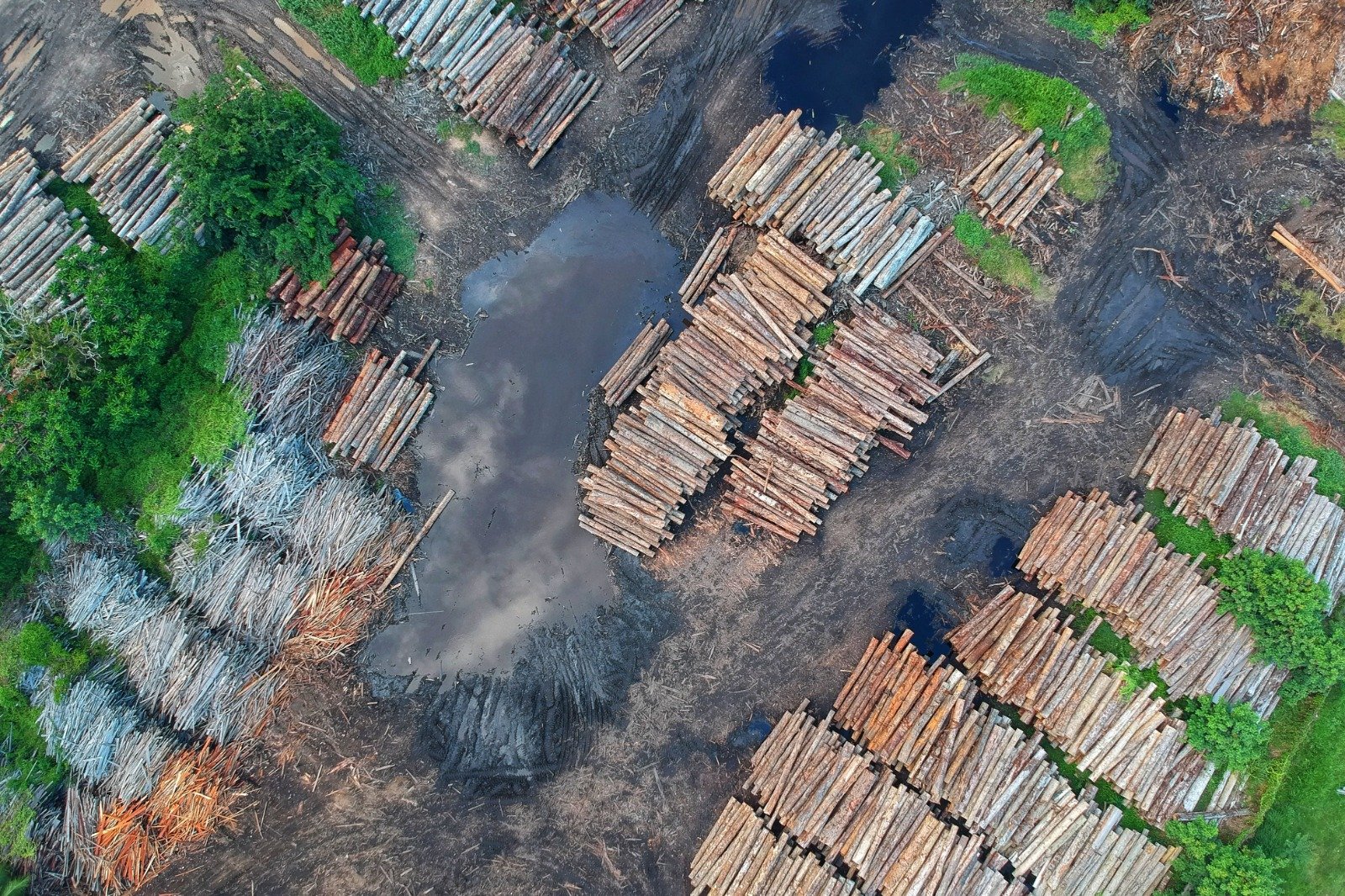The common focal point for the global warming debate is the emission of fossil fuel., that often overshadow the other significant variables such as deforestation. Deforestation and climate change are interlinked and complicated, yet significant, deforestation itself contribute approximately 12-20% greenhouse emissions globally (Van Der Werf et al., 2009). This blog aims to elucidate the intricate connections that subsist between the deforestation and climate change, emphasising the necessity to conserve forest on the priority basis as a part of more aggressive strategies to tackle the effects of the climate changing. How Does Deforestation Contribute to Global Warming? Deforestation is a substantial contributor to the green house emission and contributor approximately 12-20% of all greenhouse gas emissions (Van der Werf et al., 2009). The whole process of deforestation involves the clearing of forests for various purposes such as agriculture, urban development, and timber extraction. Below are some examples how this activity contribute to the global warming and effecting climate cycle: Carbon Emissions: Trees are called the natural carbon Sinks, as they absorb carbon dioxide (CO2) from the atmosphere during the process of photosynthesis and store it as carbon in their biomass i.e., wood, leaves, roots and help to reduce the overall concentration of the greenhouse gases in the atmosphere. (Pan et.al., 2011). The atmospheric release of stored carbon occurs when trees are burned or chopped down, or allowed to decompose, the stored carbon is released back into the atmosphere as CO2, contributing to greenhouse gas concentrations (Malhi et al., 2016, Pan et al., 2011). Deforestation also affects the regional and global water cycles. Evapotranspiration, which forms clouds and causes rainfall, is facilitated by trees. Their absence brings in a reduction in cloud cover and drier weather, which can have a warming effect (Spracklen et al., 2012). As a result of deforestation and degradation, some tropical forests now emit more carbon than they capture, turning them from a carbon ‘sink’ into a carbon source. For example, the south-eastern part of the Amazon Rainforest is now considered a net carbon source by scientists (https://www.lse.ac.uk/). Change in Albedo Effect: Solar Energy Absorption: Trees have great potential in minimizing environmental problems such as thermal stress. In this respect, canopy is one major component that can contribute in giving such impact towards microclimatic environment. Shades that are formed by canopy have correlations to foliage geometry which respond significantly towards all microclimate indicators such as solar radiation and wind velocity (Shahidan et al, 2006). When forests are removed, they are often replaced by lighter-colored surfaces, like agricultural lands, which reflect more sunlight back to space, altering the Earth’s albedo (albedo effect) and affecting climate (Bala et al., 2007). Loss of Biodiversity: Biodiversity loss indicates the reduction in the variety and variability of the lifeforms within an ecosystem, region or the planet. Such loss can include the extinction of species and also a decline in the number of population/ species/genetic variability with species and the destruction and degradation of ecosystems (Cardinale et al., 2021). Factors that cause the loss of biodiversity include habitat destruction, pollution, invasive species, overharvesting, and climate change (Sala et al., 2000). Some common examples of habitat destruction include reforestation, urbanisation, and ecosystem change for agricultural purposes. These activities both directly or indirectly lead to the loss of the habitat for various species. A diverse ecosystem is generally more resilient and better equipped to handle changes, acting as a natural buffer against climate change (Hooper et al., 2012). One example of how deforestation leads to the loss of biodiversity is the destruction of habitats for many plant and animal species. The natural equilibrium is upset when trees are removed, and this can lead to the extinction or endangered status of some species. The loss of biodiversity has significant consequences for ecosystem services, which are the benefits people obtain from ecosystems. These services include provisioning services like food and water, regulating services such as disease control, cultural services, and supporting services such as nutrient cycling (Millennium Ecosystem Assessment, 2005). Global warming due to deforestation disproportionately affects indigenous communities, which rely on forests for their livelihood and cultural practices. This introduces a social justice element into the climate change debate (Adger et al., 2003). The current rate of extinction is estimated to be tens to hundreds of times higher than the average over the last 10 million years and is predicted to increase further unless action is taken. This represents a global biodiversity crisis, often referred to as the sixth mass extinction (Ceballos et al., 2015). Mitigation Strategies: Reforestation, or planting trees on previously cleared land, and afforestation, or turning unused ground into forests, are simple yet efficient mitigation techniques (Stavins & Richards, 2005). Encouraging sustainable forest management techniques, such as controlled burns and selective logging, can assist in striking a balance between the need for conservation and the financial advantages of forestry (Nabuurs et al., 2007). More robust international regulations, including REDD+ (Reducing Emissions from Deforestation and Forest Degradation), have the objective of providing developing nations with financial incentives to invest in sustainable forestry and minimize deforestation (Angelsen et al., 2009). Deforestation contributes considerably to global warming, a fact that is frequently overlooked. Plans for sustainable management and forest protection are crucial components of climate change mitigation strategies. Neglecting this essential element would result in missing out on a crucial piece of the climate puzzle. Sustainable land-use practices, conservation efforts, restoration activities, and policies aiming to mitigate climate change are critical for curbing biodiversity loss. Implementing such actions with a global cooperative approach is essential to preserve biodiversity and maintain ecosystem services for future generations (Díaz et al., 2019). References Adger, W. N., Huq, S., Brown, K., Conway, D., & Hulme, M. (2003). Adaptation to climate change in the developing world. Progress in Development Studies, 3(3), 179-195. Angelsen, A., Brown, S., Loisel, C., Peskett, L., Streck, C., & Zarin, D. (2009). Reducing Emissions from Deforestation and Forest Degradation (REDD): An Options Assessment Report. Bala, G., Caldeira, K., Wickett, M., Phillips, T. J., Lobell, D. B., Delire,
A sustained rise in the Earth’s average surface temperature is known as global warming, and it presents an existential threat to ecosystems and species. Delays in ecosystem services that are essential for life on Earth are among the catastrophic effects, along with habitat loss and the extinction of species. This blog explores the science underlying these effects and explains why biodiversity preservation is essential to the planet’s health and ability to withstand climate change. What is Biodiversity? The variety and variability of life on Earth, including the diversity within and between species as well as among ecosystems, is referred to as biodiversity. In addition to serving as a storehouse of biological resources, rich biodiversity also offers ecological services likepollination, water purification, and climate regulation (Cardinale et al., 2012). The Toll of Global Warming Habitat Loss Global warming leads to melting glaciers, rising sea levels, and shifting climatic zones, directly affecting habitats like polar regions, coral reefs, and tropical rainforests (IPCC, 2019). One concerning effect of global warming is habitat loss, which has an impact on a wide range of ecosystems, from tropical rainforests to frigid regions. Animals that rely on ice for sleeping and hunting, such as seals and polar bears, are fighting for their lives as glaciers inpolar regions melt at a rate never seen before. under a similar vein, coastal habitats that are vital to a variety of marine species are under jeopardy due to increasing sea levels, another effect of global warming. Certain plants and animals are also finding previously friendly locations inhospitable due to the shifting borders of climatic zones brought on by rising temperatures. The ocean’s nurseries, coral reefs, are going through bleaching episodes as a result of rising sea temperatures and increased acidity, which is having an impact on whole marine ecosystems. Changes in temperature and weather patterns can disrupt the migration cycles of birds, mammals, and fish, often with fatal consequences (Robinson et al., 2009). The absorption ofexcess carbon dioxide by the oceans is making them more acidic, impacting marine biodiversity, particularly coral reefs and shell-forming organisms (Hoegh-Guldberg et al., 2007). Some estimates suggest that global warming could lead to the extinction of 25% ofthe world’s animal and plant species by the year 2050 (Thomas et al., 2004). Global warming has been observed to affect pollination patterns, which could lead to a decline in food crops that are essential for human survival (Hegland et al., 2009). Warmer temperatures can result in the uncoupling of predator-prey relationships, leading to “trophic mismatches” that can disrupt entire ecosystems (Thackeray et al., 2016). The altering climates also make it easier for invasive species to establish themselves in new ecosystems, often to the detriment of native species (Walther et al., 2009). Habitat loss due to global warming is not just an environmental issue but a crisis that impacts biodiversity, ecosystems, and potentially human civilization itself. Therefore, it’s a problem that requires immediate and coordinated global action. Why It Matters Ecosystems perform various ecological functions critical for climate regulation, including carbon sequestration, water purification, and nutrient cycling. The loss of biodiversity diminishes these functions, making ecosystems less resilient to environmental changes(Isbell et al., 2015). The consequences of global warming on biodiversity and ecosystems are profound and interlinked. Tackling this issue requires an interdisciplinary approach and the collective will of international communities. The more we understand about these impacts, the better we can develop strategies to mitigate them, ultimately working towards a more sustainable and resilient world. References
Addressing Disproportionate Impacts of Global Warming on Vulnerable Communities Climate change is often thought of as a universal problem that affects us all. However, its impacts are far from evenly distributed. Vulnerable communities bear a disproportionate brunt of the consequences, ranging from extreme weather events to sea-level rise and desertification. This blog aims to shed light on the concept of climate justice, which seeks to address these inequalities and ensure a more equitable response to climate change. The Concept of Climate Justice Climate justice is a term and concept that links human rights, social justice, and environmental sustainability. It recognizes that climate change has a disproportionate impact on communities that are socially, economically, or politically disadvantaged. It advocates for fair treatment of all people and equal access to both the shared benefits and responsibilities in addressing climate change. It seeks to rectify the social and economic injustices that exacerbate the impacts of climate change on vulnerable populations. It integrates social justice into climate change policies and actions. It aims to share theburdens and benefits of climate change and its solutions more equitably and fairly (Schlosberg, 2013). Why Climate Justice Matters? Case Studies: The Disproportionate Impact The Effect of Climate Change on Pacific Island Nations Low-lying island nations are facing existential threats due to sea-level rise and extreme weather events. Yet, their carbon footprint is negligible compared to large emitting countries (Barnett & Campbell, 2010). Certainly, the effect of climate change on PacificIsland Nations is a subject of growing concern due to the specific vulnerabilities of these regions.. The primary concerns revolve around sea-level rise, extreme weather events, and changing ecosystems, each of which threatens the livelihood, culture, and well-being of island residents. Below is a brief note that outlines some key impacts: Extreme Weather Events: Cyclones and droughts are two extreme weather occurrences that are increasingly affecting Pacific Islands. According to an Australian Bureau of Meteorology study, climate change would probably result in an increase in intense cyclones in the South Pacific region (Australian Bureau of Meteorology, 2014). Perhaps the most pressing issue facing Pacific Island Nations like Kiribati, Tuvalu, and the Marshall Islands is sea level rising. According to current forecasts, 77% of Tuvalu’s land area could be lost if sea levels rise by 1 metre by 2100 (Barnett & Campbell, 2010). Even conservative projections suggest that sustaining habitable land will be extremely difficult for a number of islands. Ecosystem Changes: Coral reef ecosystems are under jeopardy because they are essential to local livelihoods from fishing and tourism as well as biodiversity. According to Hoegh-Guldberg et al. (2007), ocean acidification and rising sea temperatures have the potential to cause coral bleachingepisodes, which can have long-term effects on these fragile ecosystems. Adaptation Measures: Despite ongoing efforts, there are still a lot of obstacles to overcome in order to adapt to and lessen these consequences through international help and sustainable practises. International cooperation is required for climate adaptation andresilience since the financial and physical requirements sometimes surpass the capacity of hese states. Pacific Island Nations face an urgent existential threat from climate change. It is critically necessary to implement effective adaptation and mitigation techniques in order to protect the population and their distinct ecosystems. Indigenous Communities Climate change threatens the traditional lifestyles of Indigenous communities, affecting everything from their food supply to cultural practices (Ford et al., 2014). Strategies for Climate Justice Conclusion In order to maintain stability and security on a worldwide scale, it is imperative that the disproportionate effects of climate change be addressed. This goes beyond simple moral obligation. With a focus on inclusivity and equity, climate justice is a strategy that incorporates social, political, and economic factors into climate policy. By addressing the institutional imbalances and inequalities that frequently increase the impacts of climate change on vulnerable populations, it provides a path for fair adaptation and mitigationstrategies. A road towards fair adaptation and mitigation strategies that guarantee all communities have the tools and assistance they require to deal with our changing climate is provided by climate justice. All stakeholders, particularly disadvantaged and vulnerablegroups, should be involved in decision-making processes concerning the adaptation and mitigation of climate change, according to proponents of climate justice. By including everyone, policies can be customised to fit the particular requirements of any community (Schlosberg, 2013). The intersections between various social issues like poverty, racial and gender injustice, and economic disparities and climate change are examined in the context of climate justice. Climate justice seeks to address these interrelated problems in order to produce more thorough and long-lasting solutions (Ciplet et al., 2015). In our pursuit of worldwide responses to climate change, the idea of climate justice needs to becentral to our work. In addition to addressing the moral implications of climate change, this will improve the efficacy of our actions by taking into account the diverse abilities of various populations to adapt and mitigate. Climate justice is not a choice; it’s a necessity for a sustainable and equitable future. References



